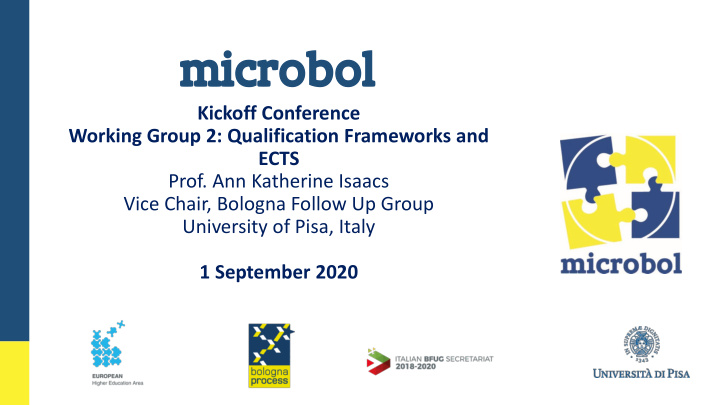



microbol Kickoff Conference Working Group 2: Qualification Frameworks and ECTS Prof. Ann Katherine Isaacs Vice Chair, Bologna Follow Up Group University of Pisa, Italy 1 September 2020
Summary ry 1. Qualifications Frameworks in the EHEA and microcredentials 2. ECTS in the EHEA and microcredentials 3. Reflections and questions
First... A question: what is a framework , and what do we need to know to explore how microcredentials can fit into one?
Today we think of ‘framework’ in IT terms. But here is the kind of framework visualized to formulate the QF-EHEA (Qualifications Framework for the European Higher Education Area):
....an empty supporting structure with a floor and a ceiling , waiting to be filled in:
In fact, the QF-EHEA (the “Overarching framework of qualifications of the European Higher Education Area”) has three stories: First, second, and third cycle (BA, MA and PhD)
The “Dublin Descriptors” – level definitions in the QF for EHEA -- are the ceilings (and the floors ). Higher Education starts at the ground floor.
The EQF (European Qualifications Framework) is compatible, because the ceilings (and the floors) of the higher education part are described differently, but are ‘of the same height’
In the QF for EHEA, the descriptors represent the ‘top’ of each ‘storey’ : the ‘level’ at the end of the process of learning, which is also quantitified in terms of time by means of ‘credit ranges’ (in terms of ECTS)
There can also be (this is optional ) a ‘short cycle’, within or ‘attached to’ the First Cycle. In the MICROBOL draft Report, a significant role is given to the short cycle, and to whether such degree programmes can offer an example for relating microcredentials to the frameworks.
I think of the framework as an empty structure , which needs to be filled.
How do we get to the level of the first, then the second and then the third story? By forming higher and higher levels of competence, as described in terms learning outcomes of single course units or educational components, until we reach the overall level which corresponds to programme learning outcomes at the height of a specific QF-EHEA /EQF «storey» and to the award of a degree. Something like a Lego construction.
What about ECTS ? In the beginning, when the HE systems in Europe were structured in very very different ways, and only a very very few used credits of any kind, ECTS was conceived as a relative value . In the absence of alternatives, it was defined as 1/60 of the student’s workload of an entire academic year.
Today ECTS represents two elements: - carefully defined learning outcomes - volume of learning related to the time usually necessary for the learner to achieve those outcomes. Now the total time corresponding to each credit is conceived as a range, in some countries slight more, in others slightly less, but in general from 25 to 30 hours of learning activities of all kinds correspond to one ECTS credit.
Today, 1 year of formal HE is still 60 credits; and each ‘floor’ of the QF (each cycle) is defined by a credit range (Bachelor 180 to 240; Master 90 to 120.) (The doctorate does not always use credits but usually lasts 3 years, thus corresponding roughly to 180 credits.)
It is easy to imagine that HEIs can offer short courses, of microcredential size, showing where they can potentially fit, for level, specific learning outcomes, and ‘size’ (volume of learning measured in time) within an existing degree programme. This already happens It is also possible to imagine that some of the small pieces offered would fit better into other learning paths, or degree programmes, and would not become part of the same Lego construction.
Are the various options covered by the existing ECTS Users’ Guide ?
In the ECTS Course Catalogue , we already have a general format for making transparent the learning, teaching and assessment methods, and the learning outcomes that comprise each course unit. Could these same elements/format be used to describe a microcredential? (A microcredential is not different to a course unit, except insofar as the ‘credential’ aspect makes it a possible ‘standalone’.)
What about a small piece of learning (microcredential size) carried out in a different way, in other contexts, outside of HE ? Could that learning be recognised (with indications of volume, level, learning outcomes) by an HEI using the method and parameters described in the ECTS Users’ Guide? Let’s discuss these issues together, to see how we understand them and what our experience suggests .
And here are some more questions: Do you think that microcredentials should have a fixed number of credits? (say 3? Or 5?) Or do you think there should be a definition of a range (such as 2 to 6, or 6 to 30)? or is this needed? What about larger or smaller units of learning («nanocredentials»?) Could they be accepted and recognized according to the same guidelines?
Do you think that microcredentials, once defined, can ‘fit into the existing qualifications frameworks ? in the ‘mainframe’ part? Or as connected units outside of the mainframe? Do you think that the existing guidelines in the ECTS Users Guide are sufficiently clear on such topics as Recognition of Prior Learning (RPL) or on the evaluation of informal and non-formal learning so that they can be used by HEIs to recognize microcredentials awarded outside of HE?
Let’s discuss these and other questions, freely, frankly, creatively and proactively! Thank you! k.isaacs@unipi.it
Recommend
More recommend